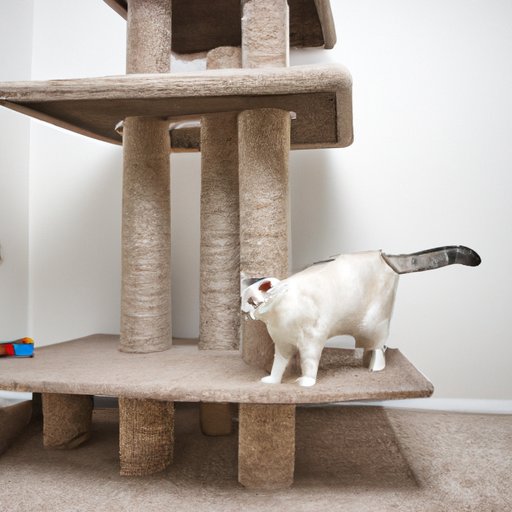I. Introduction
Have you ever walked into your kitchen to find your cat lounging on the counter? While most cat owners find this behavior frustrating, it is actually quite common. Cats love to climb and explore their surroundings, and counter-jumping is just another way for them to satisfy their curiosity. However, this behavior can be problematic as it poses a risk to their health and hygiene. With that in mind, we have put together some useful tips and tricks for keeping cats off counters.
II. Establish a designated feeding area
Cats are creatures of habit, and establishing a designated feeding area for your cat can help reduce their desire to jump on counters. By creating a consistent routine around mealtimes, cats will learn that their designated feeding area is the only place they can enjoy their meals. This provides a sense of security and predictability and reduces their need to seek out other sources of food.
When creating a designated feeding area, make sure it is in a quiet, low-traffic area of your home. Cats prefer a calm setting when they eat, so avoid placing the feeding area near noisy appliances or in the center of a busy household.
III. Use a deterrent spray
Deterrent sprays are a safe and effective way to discourage cats from jumping on your counters. These sprays work by using scents that cats dislike, such as citrus or apple cider vinegar. Spray the deterrent on your counters and watch as your cat recoils from the strong smell.
When using a deterrent spray, make sure to test it on a small, inconspicuous area first to ensure it does not damage the surface of your counter. Additionally, avoid using sprays that contain chemicals or substances that could be harmful to your cat.
IV. Install motion-activated deterrents
Motion-activated deterrents are a great option for those looking for a hands-off approach to keeping cats off counters. These devices work by detecting motion and emitting a loud noise or burst of air, startling the cat and deterring them from continuing their behavior.
When choosing a motion-activated deterrent, look for one that is specifically marketed for cats. Some devices may be more appropriate for dogs or other pets and may not be effective for deterring cats.
V. Cover the counters
Covering your counters with unappealing materials can discourage cats from jumping up. Aluminum foil is an excellent option, as cats detest the sound and texture of the foil. Double-sided tape is another deterrent that can be applied to surfaces, making it unpleasant for cats to grab hold.
When covering your counters, be sure to leave your cat with plenty of safe and comfortable areas to climb and play. By providing alternative spaces for your cat to explore, you can reduce their desire to seek out the counters.
VI. Designate play areas
Cats need stimulation and playtime to stay happy and healthy. By setting up designated play areas for your cat, you can provide them with alternative spaces to explore and play.
When creating these play areas, be sure to include toys, scratching posts, and other interactive elements that will keep your cat entertained. Providing appropriate play areas can help redirect your cat’s behavior and reduce their desire to jump on counters.
VII. Invest in a tall scratching post
Cats love to scratch and climb, and providing them with a tall scratching post can help redirect their behavior away from your counters. Tall scratching posts offer cats a designated space to climb and sharpen their claws, ensuring that they don’t turn to your countertops for this behavior.
When choosing a scratching post, look for one that is tall enough for your cat to fully stretch out and engage in their favorite scratching behaviors. Additionally, make sure the post is made of sturdy materials that can withstand regular use.
VIII. Be consistent with training
Consistency is key when it comes to training your cat to stay off counters. Establish household rules and stick to them, providing your cat with consistent reminders of what behavior is expected of them.
Positive reinforcement, such as treats and praise, can help encourage good behavior and create a positive association with staying off counters. Patience and understanding are key when training your cat, so be prepared for setbacks and challenges along the way.
IX. Conclusion
Keeping cats off counters can be a challenging task, but with the right tools and techniques, it is possible to redirect your feline friend’s behavior. From deterrent sprays to designated play areas, these tips and tricks can help keep your home clean, safe, and free of counter-jumping cats. So next time you catch your cat on the counter, remember that there are plenty of solutions available to help you solve the problem.
